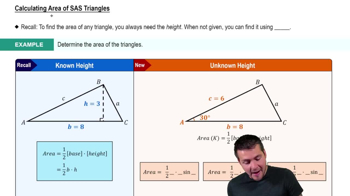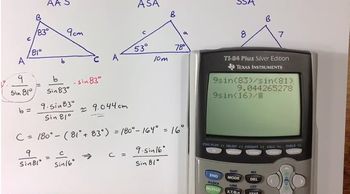Table of contents
- 0. Review of College Algebra4h 43m
- 1. Measuring Angles39m
- 2. Trigonometric Functions on Right Triangles2h 5m
- 3. Unit Circle1h 19m
- 4. Graphing Trigonometric Functions1h 19m
- 5. Inverse Trigonometric Functions and Basic Trigonometric Equations1h 41m
- 6. Trigonometric Identities and More Equations2h 34m
- 7. Non-Right Triangles1h 38m
- 8. Vectors2h 25m
- 9. Polar Equations2h 5m
- 10. Parametric Equations1h 6m
- 11. Graphing Complex Numbers1h 7m
7. Non-Right Triangles
Law of Sines
Problem 46
Textbook Question
In Exercises 45–46, find the area of the triangle with the given vertices. Round to the nearest square unit. (-2, -3), (-2, 2), (2, 1)
 Verified step by step guidance
Verified step by step guidance1
<Step 1: Identify the vertices of the triangle as points A(-2, -3), B(-2, 2), and C(2, 1).>
<Step 2: Use the formula for the area of a triangle given vertices (x1, y1), (x2, y2), (x3, y3): Area = 0.5 * |x1(y2-y3) + x2(y3-y1) + x3(y1-y2)|.>
<Step 3: Substitute the coordinates of the vertices into the formula: Area = 0.5 * |-2(2-1) + (-2)(1+3) + 2(-3-2)|.>
<Step 4: Simplify the expression inside the absolute value: Area = 0.5 * |-2(1) + (-2)(4) + 2(-5)|.>
<Step 5: Calculate the absolute value and multiply by 0.5 to find the area, then round to the nearest square unit.>
Recommended similar problem, with video answer:
 Verified Solution
Verified SolutionThis video solution was recommended by our tutors as helpful for the problem above
Video duration:
5mPlay a video:
Was this helpful?
Key Concepts
Here are the essential concepts you must grasp in order to answer the question correctly.
Coordinate Geometry
Coordinate geometry involves the study of geometric figures using a coordinate system. In this context, the vertices of the triangle are given as points in a two-dimensional plane, represented by their (x, y) coordinates. Understanding how to plot these points and visualize the triangle they form is essential for calculating its area.
Recommended video:

Intro to Polar Coordinates
Area of a Triangle
The area of a triangle can be calculated using various methods, one of which is the formula A = 1/2 * base * height. However, when given vertices in coordinate form, the area can also be determined using the determinant method, which involves the coordinates of the vertices. This method provides a straightforward way to compute the area without needing to find the base and height explicitly.
Recommended video:

Calculating Area of SAS Triangles
Determinant Method for Area
The determinant method for finding the area of a triangle formed by three points (x1, y1), (x2, y2), and (x3, y3) is given by the formula A = 1/2 | x1(y2 - y3) + x2(y3 - y1) + x3(y1 - y2) |. This formula leverages the coordinates directly to compute the area, making it particularly useful in coordinate geometry problems where vertices are provided.
Recommended video:

Calculating Area of SAS Triangles

 4:27m
4:27mWatch next
Master Intro to Law of Sines with a bite sized video explanation from Patrick Ford
Start learningRelated Videos
Related Practice


















